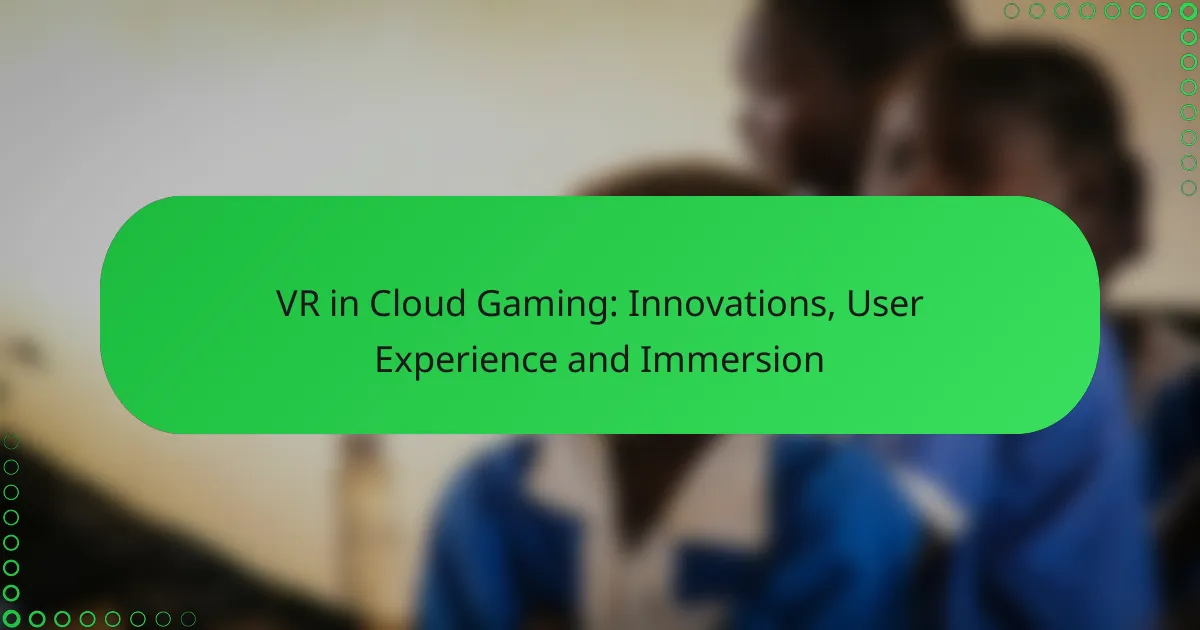The integration of virtual reality (VR) in cloud gaming is revolutionizing the way players engage with their favorite games, offering immersive environments that captivate multiple senses. Innovations in streaming technology and artificial intelligence are enhancing user experiences, making gameplay more interactive and accessible than ever before. To explore more about the latest advancements, players can check out the emerging trends in cloud gaming, which elevate their overall enjoyment and satisfaction.

How Does VR Enhance Cloud Gaming Experiences?
VR significantly enhances cloud gaming experiences by providing immersive environments that engage players on multiple sensory levels. This technology allows users to feel as if they are truly part of the game, elevating the overall enjoyment and interaction.
Immersive gameplay through VR headsets
VR headsets create a fully immersive gaming experience by surrounding players with 360-degree visuals and spatial audio. This technology allows gamers to look around and interact with their environment in a way that traditional gaming cannot match.
Popular VR headsets, such as the Oculus Quest and HTC Vive, offer varying levels of resolution and refresh rates, impacting the quality of the experience. Players should consider headset specifications to ensure optimal performance, aiming for at least 90 Hz refresh rates for smooth gameplay.
Real-time interaction with virtual environments
Real-time interaction in VR allows players to manipulate objects and navigate through virtual worlds seamlessly. This interaction is facilitated by motion controllers that track hand movements, enabling actions like picking up items or solving puzzles.
Latency is crucial in cloud gaming; ideally, it should be kept under 20 milliseconds to maintain a responsive experience. Players should ensure a stable internet connection, preferably fiber-optic, to minimize lag and enhance real-time interactions.
Enhanced social experiences in multiplayer settings
VR technology enriches social experiences by allowing players to interact with friends and other gamers in virtual spaces. Multiplayer VR games often feature avatars, enabling players to communicate and collaborate in a shared environment, making the experience more engaging.
Games like Rec Room and VRChat exemplify this social aspect, offering diverse activities and environments for players to explore together. When participating in multiplayer VR, players should be aware of their surroundings to avoid accidents and enhance their social interactions.

What Innovations Are Driving VR in Cloud Gaming?
Innovations in VR and cloud gaming are transforming how players experience immersive environments. Key advancements in streaming technology, artificial intelligence, and cross-platform compatibility are enhancing user engagement and accessibility.
Advancements in streaming technology
Streaming technology has significantly improved, allowing for low-latency gameplay and high-resolution graphics. Technologies like 5G and advanced compression algorithms enable smoother experiences, reducing lag to low tens of milliseconds. This is crucial for VR, where even slight delays can disrupt immersion.
Cloud gaming platforms are now capable of delivering VR content with minimal buffering, making it feasible for users to enjoy high-quality games without the need for powerful local hardware. Services like NVIDIA GeForce Now and Google Stadia exemplify these advancements, offering seamless VR experiences across various devices.
Integration of AI for personalized experiences
Artificial intelligence is being integrated into cloud gaming to create personalized user experiences. AI algorithms analyze player behavior and preferences, tailoring game recommendations and in-game content to enhance engagement. This can lead to more immersive and satisfying gameplay.
Additionally, AI can optimize resource allocation in cloud environments, ensuring that users receive the best possible performance based on their individual connection speeds and device capabilities. This adaptability is essential for maintaining high-quality VR experiences across diverse user setups.
Development of cross-platform compatibility
Cross-platform compatibility is becoming a standard in cloud gaming, allowing players to access VR content across various devices and operating systems. This flexibility enhances the gaming community by enabling friends to play together, regardless of their hardware choices.
Major platforms are increasingly supporting cross-play features, which not only broadens the user base but also fosters a more inclusive gaming environment. Developers are encouraged to create games that work seamlessly across different systems, ensuring that players can enjoy VR experiences without being limited by their device. This trend is likely to continue as the demand for accessible gaming grows.

What Are the User Experience Benefits of VR in Cloud Gaming?
VR in cloud gaming enhances user experience by providing immersive environments and interactive gameplay that traditional gaming cannot match. This technology allows players to engage more deeply with games, creating a more satisfying and enjoyable experience.
Increased engagement and immersion
VR technology significantly boosts engagement by placing players directly into the game world. This immersive experience allows users to interact with their surroundings in a way that feels natural and intuitive, enhancing their emotional connection to the game.
For example, in a VR shooter game, players can physically duck or lean to avoid obstacles, making the gameplay feel more realistic. This level of interaction keeps players invested for longer periods, often leading to higher satisfaction rates.
Reduced latency for smoother gameplay
Cloud gaming platforms are increasingly optimizing latency, which is crucial for a seamless VR experience. Low latency, ideally under 20 milliseconds, ensures that players’ actions are reflected in real-time, minimizing any lag that could disrupt immersion.
Technologies such as edge computing are being utilized to bring game servers closer to players, reducing the distance data must travel. This improvement is vital for fast-paced games where every millisecond counts, allowing for smoother and more responsive gameplay.
Accessibility for diverse gaming audiences
VR in cloud gaming makes gaming more accessible to a broader audience by eliminating the need for high-end hardware. Players can enjoy high-quality VR experiences on various devices, including lower-spec PCs and mobile devices, as long as they have a stable internet connection.
This accessibility opens up gaming to individuals who may not have the means to invest in expensive gaming consoles or PCs, fostering a more inclusive gaming community. Additionally, cloud gaming services often offer subscription models, allowing players to access a library of games without significant upfront costs.

What Are the Challenges of Implementing VR in Cloud Gaming?
Implementing VR in cloud gaming faces several significant challenges, primarily related to bandwidth, hardware, and user experience. These factors can hinder the overall effectiveness and enjoyment of VR gaming in a cloud environment.
High bandwidth requirements
High bandwidth is crucial for cloud gaming, especially in VR, where data transmission needs are significantly greater than traditional gaming. A stable connection with speeds often exceeding 25 Mbps is recommended to ensure smooth gameplay and reduce latency.
Users may experience lag or stuttering if their internet connection does not meet these requirements. This can lead to a frustrating gaming experience, making it essential for players to assess their connectivity before diving into VR cloud gaming.
Hardware limitations for users
Many users may face hardware limitations that affect their ability to fully engage with VR cloud gaming. This includes not only the need for a compatible VR headset but also a powerful enough device to handle streaming and processing demands.
For optimal performance, users should consider investing in high-performance PCs or consoles that can support VR applications effectively. Additionally, ensuring that peripherals such as controllers are compatible is vital for a seamless gaming experience.
Potential motion sickness issues
Motion sickness is a common concern in VR gaming, and it can be exacerbated in cloud gaming environments due to latency and lag. Users may experience discomfort if the visual feedback does not align well with their physical movements.
To mitigate these issues, players should take breaks during long sessions and gradually acclimate to VR environments. Developers can also implement comfort settings within games to help reduce the likelihood of motion sickness for users.

How Do Users Perceive VR in Cloud Gaming?
Users generally perceive VR in cloud gaming as an innovative and immersive experience, blending the convenience of cloud technology with the engaging nature of virtual reality. This combination enhances gameplay by providing a more interactive environment, although some users express concerns about latency and performance.
User satisfaction ratings
User satisfaction ratings for VR in cloud gaming vary significantly, often influenced by factors such as internet speed and hardware compatibility. Many users report high satisfaction levels when playing on stable connections, with ratings typically ranging from 70% to 90% positive feedback. However, those with slower connections often express dissatisfaction due to lag and reduced visual quality.
Feedback on immersive experiences
Feedback on immersive experiences in VR cloud gaming highlights a strong appreciation for the sense of presence and interactivity that VR provides. Users frequently mention the enhanced realism and engagement compared to traditional gaming, with many noting that the ability to physically interact with the game world significantly boosts their enjoyment. However, some players report discomfort or motion sickness, which can detract from the overall experience.
Comparative analysis with traditional gaming
When comparing VR cloud gaming to traditional gaming, users often cite differences in immersion and accessibility. VR offers a unique, 360-degree experience that traditional gaming cannot replicate, but it requires more advanced hardware and a reliable internet connection. Many players find that while VR provides a more engaging experience, traditional gaming remains preferable for those seeking straightforward gameplay without the need for specialized equipment.

What Criteria Should Be Considered When Choosing VR Cloud Gaming Platforms?
When selecting a VR cloud gaming platform, consider factors such as performance metrics, latency, content library, and user experience. These elements significantly impact how immersive and enjoyable your gaming experience will be.
Performance metrics and latency
Performance metrics and latency are crucial for a seamless VR cloud gaming experience. Latency, measured in milliseconds, indicates the delay between user input and the game’s response. Ideally, latency should be below 20 ms for an optimal experience, as higher delays can lead to motion sickness and frustration.
When evaluating platforms, look for those that provide low latency and high frame rates, typically around 60 frames per second or higher. This ensures smooth visuals and responsive controls, which are essential for immersive gameplay.
Additionally, consider the bandwidth requirements of the platform. A stable internet connection with at least 15-25 Mbps is recommended for VR gaming to maintain quality without interruptions. Always check the platform’s specifications to ensure your setup meets these criteria.
